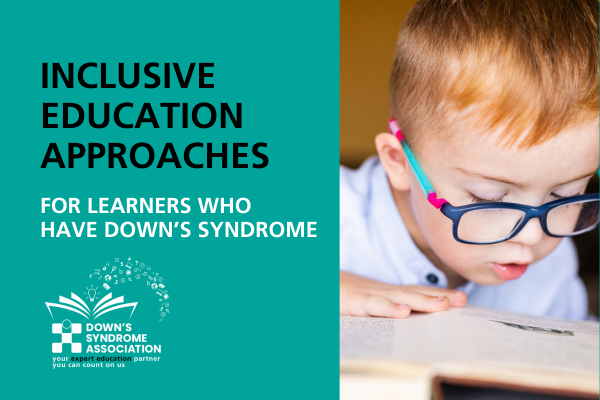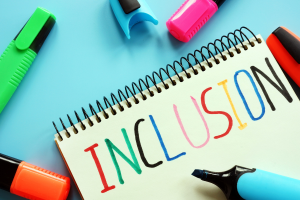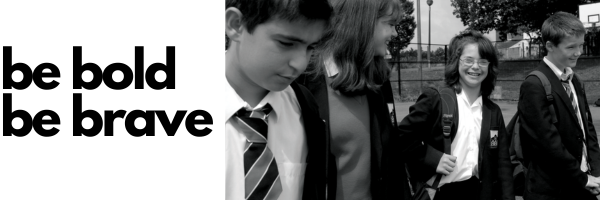How to develop inclusive education approaches for learners who have
Down’s syndrome
Education leaders need to be committed to their role in driving the cultural change required to develop an inclusive education setting where diversity is valued and disabled learners are welcomed.
Settings should establish a shared vision and framework for inclusion that underpins the setting’s overall aims and objectives, by working in partnerships with all staff, pupils, families and the broader community.
It is important that everyone is bought in to inclusion, which will make it more likely to be successful in implementation than if it is being forced on some individuals.

For further information and guidance, please see the International Guidelines for the Education of Learners with Down’s syndrome.
Key staff should be identified who will lead on the inclusion project in your setting.
This does not need to be the most senior or experienced members of the team. Their role will be to listen to the opinions of staff, pupils, families and the wider community, to reflect on possibilities and ideas for developing inclusion and how this can be implemented in the setting.
Through this process, agree what the term ‘inclusive education’ or ‘inclusion’ means within your school and what experiences you are hoping to provide for all learners in your school. It is important that these advocates are able to articulate their goal of full inclusion in school to others, and to convince the school community.
They can also act as a role model, interacting with students in and outside class to build rapport, teach or offer positive behaviour supports.
Settings should not focus all of their energy on resourcing an individual child (or small group of children) but look at how the school as a whole can be developed over time to cater more effectively for a broader range of children.
Consider how all school activities need to be developed to become more inclusive, not just lesson time (breakfast club, break times, lunch groups, school plays, field trips etc).
It is important that all staff are made aware of their responsibilities under the newly agreed vision and policy of inclusion and how it is the right of every child to receive an inclusive education. Education leaders should provide opportunities for all staff, including learning support assistants, to undertake professional development on aspects of inclusive practice.
It is important that individual teachers are given the support, time, training and backing of the school leadership team to be bold and be brave, and to continually develop their inclusive practice. Fears, failures, and frustrations are inevitable. There may not be immediate successes – it may take some time and imagination to develop and implement inclusive approaches, but what is important is a commitment to moving forwards instead of staying the same. Teachers should be supported through the establishment of networks and communities of practice, where planning and ideas can be shared.


Ensure that when you are planning for lessons you include all children in what the rest of the class are doing, even if the work or activity needs to be adapted.
Be imaginative and creative in your differentiation and planning. Talk to the pupil’s parents to find out what interests or engages them and build this into your approach. Decisions about what is taught to learners with Down’s syndrome should be framed around the right to a broad and balanced curriculum and extra-curricula opportunities, on an equal basis with others, and not based on predictions about what will be needed for adulthood.
The education of a person with Down’s syndrome is the responsibility of everyone in the setting. If new initiatives are tried as a whole school, the risk of failure is not a burden for the few, many more children are given interesting and beneficial opportunities, plus many more staff are prepared and up skilled for the future.
Talk to the children in your classroom about inclusion and find out what is important to them. Discuss your expectations of them regarding inclusion, partner/teamwork, respect, diversity, and disabilities. Explain how they will be expected to interact with and support one another, and that this is as important as academic achievement in your eyes. Recognise that pupils without disability in the regular classroom are an important resource, as are the disabled learners.
There should also be pro-active engagement of parents, carers and services to support the education of individual learners. Listen to the parents/carers and share their perspectives and ideas with all staff. Record what works and what doesn’t, whilst understanding that this can be a fluctuating and changeable path throughout the learner’s school journey (as with many
children).

Set up your classroom with the pupils you will be teaching in mind. Think about desk layout, access to resources, seating positions/rotations, proximity to the interactive white board (IWB)/friends/staff etc.
Take time to regularly reflect and discuss your inclusive practice. Seek feedback, adopt a positive approach to problem-solving and find networks of other teachers and school leaders who are committed to inclusive education with who you can share ideas of what works well and ask for help when you need it. Spend time learning and reading about the huge variety of conditions/diagnoses and special educational needs you are coming into contact with but remember that no two children nor their circumstances are the same. Treat each child in your class as an individual and properly get to know the learner who has Down’s syndrome (their personality, likes, and dislikes) as you would all other pupils in your classroom. Share this information with other colleagues and encourage them to get to know the pupil too.
